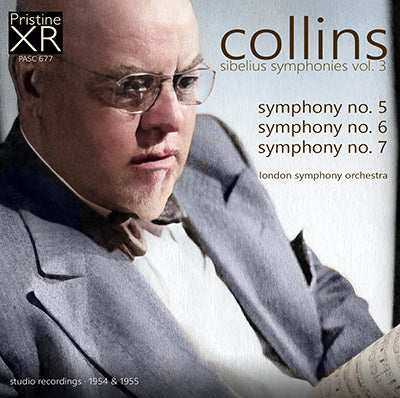
This album is included in the following sets:
This set contains the following albums:
- Producer's Note
- Full Track Listing
- Cover Art
During the First World War Sibelius as a composer led his life "on two levels". His contacts with the outside world were sparse because of the war, and financial pressures forced him to produce a great number of small pieces for Finnish publishers. At the same time he was planning an entirely new kind of symphony. He would write three different versions of it before he was satisfied with the result.
Sibelius had been thinking about the fifth symphony, at least since the spring of 1912 when he was working on other pieces. In the summer of 1914, just after the outbreak of the First World War, he wrote that he had got an idea for "a lovely theme". Then in the autumn of 1914 he wrote a prophecy to his friend Axel Carpelan: "Another depth of misery. But I can already make out the mountain that I shall ascend (…) God is opening his doors for a moment, and his orchestra is playing the fifth symphony."
While Sibelius’s diary notes show that his mood during the fourth symphony was one of determination, the initial stages of the fifth symphony seemed to be filled with ecstasy. "The autumn sun is shining. Nature in its farewell colours. My heart is singing sadly – the shadows grow longer. The Adagio of my fifth symphony? That I, poor fellow that I am, can have moments of such richness!!" he wrote on 10th October 1914. And in November the sentiment grew even stronger: "I have a lovely theme. An adagio for the symphony – earth, worms and misery, fortissimo and sordinos [mutes], lots of sordinos. And the melodies are divine!!"
Sibelius found themes for the sixth symphony while working on the fifth, and some of the material was originally drafted for a lyrical violin concerto. Somewhat later Sibelius was for a time considering a work to be called Kuutar (Luna): thematic material from this also ended up in the sixth symphony.
The symphony was performed for the first time on 19th February 1923. The composer conducted the orchestra himself. The critics praised the "pure idyll" of the symphony, but they would clearly have wished for stronger dramatic contrasts.
Today the sixth symphony is recognised as a masterpiece. Its meaning often becomes accessible only after one has become familiar with the heroism of the second and fifth symphonies, or the profundity of the fourth and seventh symphonies.
Sibelius was going through difficult times in 1923-1924, when he was completing the seventh symphony. He had gone on a tour of Stockholm, Rome and Gothenburg and conducted successfully. However, before the last concert he had taken alcohol. When the concert started Sibelius thought for a moment that he was at a rehearsal and interrupted the performance. The concert went well after this, but Aino, who was sitting in the audience, was terrified. "Everything was chaos in my ears, I was in a state of mortal terror," she said later. From then on, Aino refused to attend concerts in which her husband was conducting.
Sibelius quite often took alcohol to ease his stage fright and the tremor in his hands, which was getting worse with age. Even at home in Ainola it was difficult for him to continue writing the seventh symphony without taking a few glasses to steady his hand. A prohibition law was in force in Finland at the time, and Sibelius was forced to obtain alcohol as a prescription drug.
But the seventh symphony had been slowly maturing in his head for almost ten years, ever since an adagio motif had appeared in his fifth symphony sketchbook. The motif expanded and took on a life of its own, becoming the root of the seventh symphony. In 1918 he wrote: "The seventh symphony. Joy of life and vitality mixed with appassionato. Three movements – the last of them a 'Hellenic rondo'."
But the three-movement plan changed; it was now a work in one movement, and Sibelius was ready to sacrifice his own health for it. The symphony was the result of ten years of contemplation and nothing could prevent the transfer of the masterpiece from the composer's brain onto paper.
Notes from Sibelius – The Website: http://www.sibelius.fi
COLLINS The Sibelius Symphonies, Volume 2
SIBELIUS Symphony No. 5 in E-flat major, Op. 82
1. 1st mvt. - Tempo molto moderato (13:05)
2. 2nd mvt. - Andante mosso, quasi allegretto (8:33)
3. 3rd mvt. - Allegro molto (8:17)
Recorded Kingsway Hall, London, 25-27 January 1955
First issued as Decca LXT 5083
SIBELIUS Symphony No. 6 in D minor, Op. 104
4. 1st mvt. - Allegro molto moderato - Poco tranquillo (8:36)
5. 2nd mvt. - Allegretto moderato - Poco con moto - Poco a poco meno piano - Tempo I (6:48)
6. 3rd mvt. - Poco vivace (3:30)
7. 4th mvt. - Allegro molto - Allegro assai - Doppio più lento (9:48)
Recorded Kingsway Hall, London, 25-27 January 1955
First issued as Decca LXT 5084
8. SIBELIUS Symphony No. 7 in C major, Op. 105 (19:48)
Recorded Kingsway Hall, London, 22-25 February 1954
First issued as Decca LXT 2960
London Symphony Orchestra
conducted by Anthony Collins
XR Remastered in Ambient Stereo by Andrew Rose
Cover artwork based on a photograph of Anthony Collins
Decca studio recordings
Producer: Victor Olof
Engineer: Kenneth Wilkinson
Total duration: 78:25

